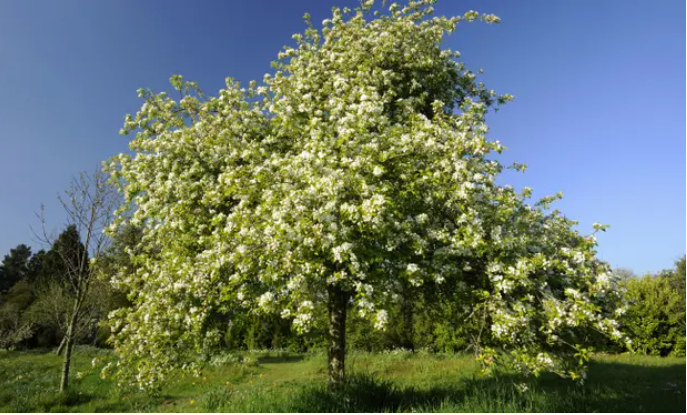A century ago, small orchards were the glory not only of the countryside but of towns and cities across the UK, buzzing with life during the summer and, at this time of year, rich with the sight and scent of blossom.
But research released as this spring’s blossom sweeps across the UK has found there are 80% fewer small “traditional” orchards, which are regarded as particularly important for flora and fauna, in England and Wales compared with in 1900.
Even taking into account large commercial concerns, which are not as ecologically rich, the two countries have lost more than half of all orchard space since then. A century ago, small orchards were the glory not only of the countryside but of towns and cities across the UK, buzzing with life during the summer and, at this time of year, rich with the sight and scent of blossom.
But research released as this spring’s blossom sweeps across the UK has found there are 80% fewer small “traditional” orchards, which are regarded as particularly important for flora and fauna, in England and Wales compared with in 1900.
Even taking into account large commercial concerns, which are not as ecologically rich, the two countries have lost more than half of all orchard space since then.
According to a report from the National Trust, the south-west of England is one of the regions hardest hit, with the area of orchards that have vanished equating to almost twice the size of the city of Bristol.
There have been dramatic losses in the north of England, where declines of about 80% have been found. As cities and towns have expanded, they have lost most of their orchards, with London having only 3% left and Cheltenham in Gloucestershire 1%.
In urban areas, orchards have mostly been lost to housing and other types of development, while in the countryside they have been uprooted to create more farmland, the report says.
Kent is the English county that has the highest total coverage today but this is because of the number of large commercial orchards rather than the speckling of traditional, more nature-filled ones. The decline along the English and Welsh border has been less steep than in other regions.
Tom Dommett, the head of historic environment at the National Trust, said that for centuries orchards were a defining feature of neighborhoods, part of the fabric of everyday life. He said: “Their loss affects local culture, how we all experience landscapes, and it means fewer opportunities for people to enjoy the beauty and spectacle of blossom.”
Traditional orchards are defined as sites with at least five trees managed in a low-intensity way, the floor grazed or mowed with little or no chemical input.
Dommett continued: “The loss of traditional orchards is also nature’s loss; these orchards can be great places for wildlife like flies and bees, with the gnarled trunks and branches creating the perfect home for rare species.”
The first Covid lockdown two years ago prompted the conservation charity to launch its first “blossom watch” campaign, encouraging people to look out for and share images of blossom.
It is stepping up its drive this year, trying to inspire a British version of the Japanese blossom celebration, hanami.
But it has also undertaken in-depth research to find out how many orchards are left. The trust used a firm specializing in artificial intelligence to compare orchards in England and Wales marked on Ordnance Survey maps from the turn of the 20th century with modern OS maps, data from People’s Trust for Endangered Species and Natural England.
The National Trust has committed to planting 4m blossom trees in England, Wales and Northern Ireland by 2030 and to set up more traditional orchards on its land.
John Deakin, the head of trees and woodland at the trust, said: “Traditional orchards and the blossom they bring creates valuable early nectar sources for insects which are often foraging for scarce resources in the early spring.
“These native, historic varieties, together with other trees like blackthorn and hawthorn which also have amazing spring blossom, mature at a faster rate than other larger native species such as oak. They provide an important bridge for insects that rely on their particular ecosystems which is one of the reasons why planting more blossom trees is such a vital part of our ambitions.”
One of the projects being launched this year is a scheme to bring more orchard trees into Birmingham, once known as a city “ringed with blossom”. In Birmingham in 1900 there were 186 hectares (460 acres) of orchards, compared with 29 today.
As part of the Birmingham 2022 festival, a six-month celebration of creativity around the 2022 Commonwealth Games, the trust is creating two pop-up blossom gardens in the city center and is to recreate a symbolic ring of new trees around Birmingham planted on the 27-mile No 11 outer circle bus route.
… we have a small favor to ask. Millions are turning to the Guardian for open, independent, quality news every day, and readers in 180 countries around the world now support us financially.
We believe everyone deserves access to information that’s grounded in science and truth, and analysis rooted in authority and integrity. That’s why we made a different choice: to keep our reporting open for all readers, regardless of where they live or what they can afford to pay. This means more people can be better informed, united, and inspired to take meaningful action.
In these perilous times, a truth-seeking global news organization like the Guardian is essential. We have no shareholders or billionaire owner, meaning our journalism is free from commercial and political influence – this makes us different. When it’s never been more important, our independence allows us to fearlessly investigate, challenge and expose those in power.











